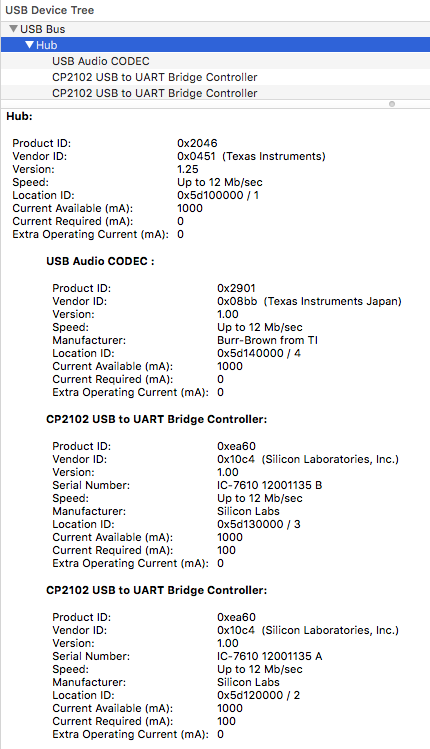
Discover 7610
version 1.0
Kok Chen
W7AY [w7ay
(at) arrl . net]
Last updated: Jan 16, 2018
1 Introduction
Discover 7610 is a program to
enumerate the ports in the USB 1 connector in the rear
panel of the Icom IC-7610.
The USB 1 (USB 2.0 Type B) connector at the IC-7610 is
attached to a USB Hub. Three devices are attached to this
hub; an audio codec for line audio input/output, a USB
serial port for the built-in RTTY/PSK decoder, and a serial
port for the CI-V (Icom's CAT (Computer Aided Transceiver)
control protocol).
2 User
Interface

The /dev path name is the name
you will need to configure the CAT port for programs such
as wsjt-x.
3 System
Requirements
Discover 7610 requires Mac OS X 10.9
(Mavericks) or newer. It also requires the Silicon Labs Mac
OS X driver to be previously installed.
4 Download
The application and Xcode project can be
downloaded from the download page.
5 Details
The hub and the three devices can be seen in the USB Device
Tree (MacOS X System Information) when the USB port is
connected to the computer. Note that these ports will
appear in the USB Device Tree even if you have not
installed the Silicon Labs driver.

The Audio Codec is a 16-bit Burr-Brown/TI codec, and
identifies itself to MacOS X as a generic "USB Audio
CODEC."
The two Silicon Labs CP2102 USB UARTs appear in MacOS X's
/dev directory as "cu.SLAB_USBtoUARTxx" and
"tty.SLAB_USBtoUARTxx", where xx can be empty, or a one or
two digit number. There is no practical difference between
using the "cu" path or the "tty" path.
There is nothing in /dev that identifies which port
corresponds to the CI-V or the RTTY decoder port. Indeed,
if you have other Silicon Labs CP2102 serial ports
connected to the computer, there is no way to distinguish
them from the IC-7610 ports.
Programs such as wsjt-x requires you to select the /dev
port for CAT. The knowledge of which is the SLAB devices is
the CAT port is desirable.
Although the /dev paths don't show it, the USB serial
number field of the CP2102 (see above figure) actually
identifies the port as an IC-7610, together with the
transceiver's serial number and whether it is the "A" or
"B" port . The CI-V port is also the first port connected
to the internal ub of the IC-7610.
Th strategy used in Discover 7610 is to traverse the USB
device tree to look for a USB serial number string that
matches the Icom 7610. The USB device info also contains a
bsd name (e.g.,
"SLAB_USBtoUART"). It then enumerates all serial ports in
/dev and look for pathnames that match the same USB bsd
name. The USB location ID distinguishes which is the CI-V
port, and which is the RTTY decoder port.
At the same time, Discover 7610 also looks for an audio
codec that is to the same USB tree level as the two SiLabs
ports.